Electrolytic cells Study guides, Class notes & Summaries
Looking for the best study guides, study notes and summaries about Electrolytic cells? On this page you'll find 179 study documents about Electrolytic cells.
Page 4 out of 179 results
Sort by
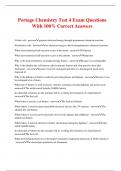
-
Portage Chemistry Test 4 Exam Questions With 100% Correct Answers
- Exam (elaborations) • 5 pages • 2024
-
- $10.49
- + learn more
Portage Chemistry Test 4 Exam Questions With 100% Correct Answers Voltaic cell - answergenerate electrical energy through spontaneous chemical reactions Electrolytic cells - answeruses electrical energy to drive nonspontaneous chemical reactions What electrochemical half-reaction occurs at the anode - answerOxidation What electrochemical half-reaction occurs at the cathode - answerReduction Why is the lead-acid battery secondary/storage battery - answerBecause it is rechargeable Why is th...
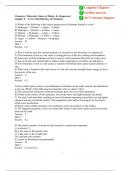
-
Test Bank for Chemistry: The Molecular Nature of Matter, 8th Edition by Jespersen
- Exam (elaborations) • 922 pages • 2024
-
- $39.49
- + learn more
Test Bank for Chemistry: The Molecular Nature of Matter, 8th Edition 8e by Neil D. Jespersen, Alison Hyslop. Full Chapters test bank are included with answers - Chapter 1 to 22 included 0 A Very Brief History of Chemistry 1 0.1 Chemistry’s Important Concepts 2 0.2 Supernovas and the Elements 3 0.3 Elements and the Earth 5 0.4 Dalton’s Atomic Theory 7 0.5 Internal Structure of the Atom 8 Tools for Problem Solving 20 Review Questions and Problems 21 1 Scientific Meas...
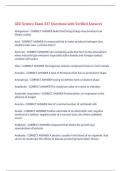
-
GED Science Exam 337 Questions with Verified Answers,100% CORRECT
- Exam (elaborations) • 27 pages • 2023
- Available in package deal
-
- $12.99
- + learn more
GED Science Exam 337 Questions with Verified Answers Abiogenesis - CORRECT ANSWER Belief that livings things may develop from lifeless matter Acid - CORRECT ANSWER A compound that In water produces hydrogen ions, usually tastes sour, a pH less than 7 Acid rain - CORRECT ANSWER rain containing acids that form in the atmosphere when industrial gas emissions (especially sulfur dioxide and nitrogen oxides) combine with water Alloy - CORRECT ANSWER Homogenous mixture composed of two or mo...
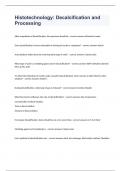
-
Histotechnology: Decalcification and Processing questions with 100% complete solutions
- Exam (elaborations) • 3 pages • 2023
- Available in package deal
-
- $9.99
- + learn more
Histotechnology: Decalcification and Processing After completion of decalcification, the specimen should be - correct answers Washed in water Over decalcification is more noticeable in staining of nuclei or cytoplasm? - correct answers Nuclei Acid solutions soften bone by removing what type of salts? - correct answers Calcium salts What type of acid is a chelating agent used in decalcification? - correct answers EDTA (ethylene diamine tetra acetic acid) To offset the hydrolysis of n...
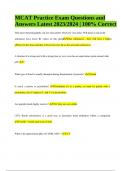
-
MCAT Exam Practice Questions With Answers Latest Updated 2024 (100% Verified)
- Exam (elaborations) • 19 pages • 2024
-
- $15.49
- + learn more
MCAT Exam Practice Questions With Answers Latest Updated 2024 (100% Verified) Thin layer chromatography can use silica plates which are very polar. Will polar or non polar substances have lower Rf values on this plate? Polar substances - they will have a higher affinity for the silica and thus will not travel as far as the non polar substances A titration of a strong acid with a strong base or vice versa has an equivalence point around what pH? 7 What type of bond is usually disrupted duri...
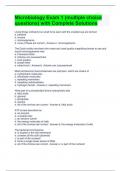
-
Microbiology Exam 1 (multiple choice questions) with Complete Solutions
- Exam (elaborations) • 5 pages • 2024
- Available in package deal
-
- $10.49
- + learn more
Microbiology Exam 1 (multiple choice questions) with Complete Solutions Most biochemical macromolecules are polymers, which are chains of a. hydrophobic molecules b. electrolytic molecules c. repeating monomers d. repeating carbohydrates e. hydrogen bonds - Answer-c. repeating monomers What part of a phospholipid forms hydrophobic tails a. fatty acids b. glycerol c. phosphate d. alcohol e. all of the choices are correct - Answer-a. fatty acids ATP is best described as a. an e...
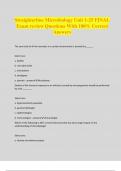
-
Straighterline Microbiology Unit 1-25 FINAL Exam review Questions With 100% Correct Answers
- Exam (elaborations) • 52 pages • 2024
- Available in package deal
-
- $14.49
- + learn more
Straighterline Microbiology Unit 1-25 FINAL Exam review Questions With 100% Correct Answers The sum total of all the microbes in a certain environment is termed the______ Select one: a. biofilm b. microbial niche c. microbiome d. phylogeny e. domain - answerMicrobiome Studies of the immune response to an infection caused by microorganisms would be performed by a/an _______. Select one: a. hypersensitivity specialist b. geomicrobiologist c. epidemiologist d. immunologist - answerI...

-
CHEM 102 Exam 4 Exam Questions with Latest Update
- Exam (elaborations) • 3 pages • 2024
- Available in package deal
-
- $9.49
- + learn more
Anode - ANSWER-Where oxidation occurs Cathode - ANSWER-Where reduction occurs Electrolysis - ANSWER-Use of electric energy to drive nonspontaneous chemical reaction Electrolytic cell - ANSWER-Carries out electrolysis Overvoltage - ANSWER-Difference between the calculated voltage and the actual voltage required to cause electrolysis Standard reduction potential - ANSWER-tendency for a chemical species to be reduced, the more positive the potential the more likely it is to be reduce...
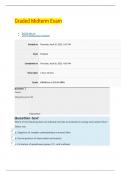
-
Microbiology: Graded Midterm Exam • BIO250_MH_V6 • Unit 12: Antimicrobial Treatment Started on Thursday, April 20, 2023, 2:55 PM State Finished Completed on Thursday, April 20, 2023, 4:05 PM Time taken 1 hour 10 mins Grade 196.00 out of 200.00 (98%)
- Exam (elaborations) • 29 pages • 2023
- Available in package deal
-
- $7.99
- + learn more
Microbiology: Graded Midterm Exam • BIO250_MH_V6 • Unit 12: Antimicrobial Treatment Started on Thursday, April 20, 2023, 2:55 PM State Finished Completed on Thursday, April 20, 2023, 4:05 PM Time taken 1 hour 10 mins Grade 196.00 out of 200.00 (98%) Question 1 Correct 4.00 points out of 4.00 Flag question Question text Which of the following does not indicate microbe involvement in energy and nutrient flow? Select one: a. Digestion of complex carbohydrates in animal diets ...
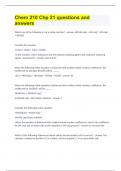
-
Chem 210 Chp 21 questions and answers
- Exam (elaborations) • 5 pages • 2023
- Available in package deal
-
- $14.99
- + learn more
Which one of the following is not a redox reaction? Al(OH)4-(aq) + 4H+(aq) ® Al3+(aq) + 4H2O(l) Consider the reaction CuO(s) + H2(g) ® Cu(s) + H2O(l) In this reaction, which substances are the oxidant (oxidizing agent) and reductant (reducing agent), respectively? CuO and H2 When the following redox equation is balanced with smallest whole number coefficients, the coefficient for nitrogen dioxide will be _____. I2(s) + HNO3(aq) ® HIO3(aq) + NO2(g) + H2O(l) 10 When t...

$6.50 for your textbook summary multiplied by 100 fellow students... Do the math: that's a lot of money! Don't be a thief of your own wallet and start uploading yours now. Discover all about earning on Stuvia


